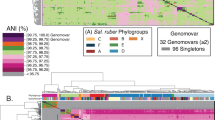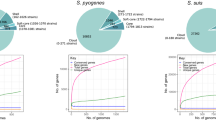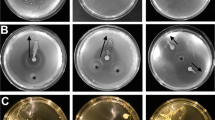Abstract
Horizontal gene transfer (HGT) is widespread in the microbial world, but its impact on the origin and persistence of microbial species remains poorly defined. HGT can result in either acquisition of new genetic material or homologous replacement of existing genes. The evolutionary significance of homologous recombination in a population can be quantified by examining the relative rates at which polymorphisms are introduced from recombination (ρ) and mutation (θw). We used multilocus sequence analysis (MLSA) to quantify both intraspecies and interspecies homologous recombination among streptomycetes, multicellular Gram-positive bacteria ubiquitous in soil, which are an important source of antibiotics and bioactive compounds. Intraspecies recombination was examined using strains of Streptomyces flavogriseus isolated from soils at five locations spanning 1000 km. The strains had >99.8% nucleotide identity across the loci examined. We found remarkable levels of gene exchange within S. flavogriseus (ρ/θw=27.9), and found that the population was in linkage equilibrium (standardized index of association=0.0018), providing evidence for a freely recombining sexual population structure. We also examined interspecies homologous recombination among different Streptomyces species in an MLSA data set and found that 40% of the species had housekeeping genes acquired through HGT. The recombination rate between these named species (ρ/θw=0.21) exceeds that observed within many species of bacteria. Despite widespread gene exchange in the genus, the intraspecies recombination rate exceeded the interspecies rate by two orders of magnitude suggesting that patterns of gene exchange and recombination may shape the evolution of streptomycetes.
Similar content being viewed by others
Log in or create a free account to read this content
Gain free access to this article, as well as selected content from this journal and more on nature.com
or
Accession codes
References
Alacevic M . (1963). Interspecific recombination in Streptomyces. Nature 197: 1323.
Anderson AS, Wellington EMH . (2001). The taxonomy of Streptomyces and related genera. Int J Syst Evol Microbiol 51: 797–814.
Bryant D, Moulton V . (2004). Neighbor-Net: an agglomerative method for the construction of phylogenetic networks. Mol Biol Evol 21: 255–265.
Chater KF, Hopwood DA, Kieser T, Thompson CJ . (1982). Gene cloning in Streptomyces. Curr Top Microbiol Immunol 96: 69–95.
Didelot X, Falush D . (2007). Inference of bacterial microevolution using multilocus sequence data. Genetics 175: 1251–1266.
Doolittle WF, Bapteste E . (2007). Pattern pluralism and the Tree of Life hypothesis. Proc Natl Acad Sci USA 104: 2043–2049.
Elnakeeb MA, Lecheval HA . (1963). Selective isolation of aerobic actinomycetes. Appl Microbiol 11: 75–85.
Eppley JM, Tyson GW, Getz WM, Banfield JF . (2007). Genetic exchange across a species boundary in the archaeal genus Ferroplasma. Genetics 177: 407–416.
Falush D, Stephens M, Pritchard JK . (2003). Inference of population structure using multilocus genotype data: linked loci and correlated allele frequencies. Genetics 164: 1567–1587.
Feil EJ, Maiden MCJ, Achtman M, Spratt BG . (1999). The relative contributions of recombination and mutation to the divergence of clones of Neisseria meningitidis. Mol Biol Evol 16: 1496–1502.
Fraser C, Alm EJ, Polz MF, Spratt BG, Hanage WP . (2009). The bacterial species challenge: making sense of genetic and ecological diversity. Science 323: 741–746.
Fraser C, Hanage WP, Spratt BG . (2007). Recombination and the nature of bacterial speciation. Science 315: 476–480.
Guo YP, Zheng W, Rong XY, Huang Y . (2008). A multilocus phylogeny of the Streptomyces griseus 16S rRNA gene clade: use of multilocus sequence analysis for streptomycete systematics. Int J Syst Evol Microbiol 58: 149–159.
Hanage WP, Fraser C, Spratt BG . (2005). Fuzzy species among recombinogenic bacteria. BMC Biol 3: 6.
Haubold B, Hudson RR . (2000). LIAN 3.0: detecting linkage disequilibrium in multilocus data. Bioinformatics 16: 847–848.
Hopwood DA . (2006). Soil to genomics: the Streptomyces chromosome. Annu Rev Genet 40: 1–23.
Hopwood DA, Lydiate DJ, Malpartida F, Wright HM . (1985). Conjugative sex plasmids of Streptomyces. Basic Life Sci 30: 615–634.
Hunt DE, David LA, Gevers D, Preheim SP, Alm EJ, Polz MF . (2008). Resource partitioning and sympatric differentiation among closely related bacterioplankton. Science 320: 1081–1085.
Huson DH, Bryant D . (2006). Application of phylogenetic networks in evolutionary studies. Mol Biol Evol 23: 254–267.
Ishaque M, Kluepfel D . (1980). Cellulase complex of a mesophilic streptomyces strain. Can J Microbiol 26: 183–189.
Kampfer P, Kroppenstedt RM, Dott W . (1991). A numerical classification of the genera Streptomyces and Streptoverticillium using miniaturized physiological tests. J Gen Microbiol 137: 1831–1891.
Kataoka M, Seki T, Yoshida T . (1991). Regulation and function of the Streptomyces plasmid psn22 genes involved in pock formation and inviability. J Bacteriol 173: 7975–7981.
Koeppel A, Perry EB, Sikorski J, Krizanc D, Warner A, Ward DM et al. (2008). Identifying the fundamental units of bacterial diversity: a paradigm shift to incorporate ecology into bacterial systematics. Proc Natl Acad Sci USA 105: 2504–2509.
Konstantinidis KT, Tiedje JM . (2005). Genomic insights that advance the species definition for prokaryotes. Proc Natl Acad Sci USA 102: 2567–2572.
Lomovskaya ND, Voeykova TA, Mkrtumian NM . (1977). Construction and properties of hybrids obtained in interspecific crosses between Streptomyces coelicolor A3(2) and Streptomyces griseus Kr15. J Gen Microbiol 98: 187–198.
Mallet J . (2008). Hybridization, ecological races and the nature of species: empirical evidence for the ease of speciation. Philos Trans R Soc Lond B Biol Sci 363: 2971–2986.
Martin DP, Williamson C, Posada D . (2005). RDP2: recombination detection and analysis from sequence alignments. Bioinformatics 21: 260–262.
McVean G, Awadalla P, Fearnhead P . (2002). A coalescent-based method for detecting and estimating recombination from gene sequences. Genetics 160: 1231–1241.
Papke RT, Zhaxybayeva O, Feil EJ, Sommerfeld K, Muise D, Doolittle WF . (2007). Searching for species in haloarchaea. Proc Natl Acad Sci USA 104: 14092–14097.
Perez-Losada M, Browne EB, Madsen A, Wirth T, Viscidi RP, Crandall KA . (2006). Population genetics of microbial pathogens estimated from multilocus sequence typing (MLST) data. Infect Genet Evol 6: 97–112.
Sheppard SK, McCarthy ND, Falush D, Maiden MCJ . (2008). Convergence of Campylobacter species: implications for bacterial evolution. Science 320: 237–239.
Shimodaira H, Hasegawa M . (1999). Multiple comparisons of log-likelihoods with applications to phylogenetic inference. Mol Biol Evol 16: 1114–1116.
Shirling EB, Gottlieb D . (1970). Report of the International Streptomyces Project 5 Years of Collaborative Research. Prauser H (Ed). The Actinomycetales. The Jena International Symposium on Taxonomy, 439pIllus Veb Gustav Fischer Verlag: Jena E, Germany, 79–89.
Stoycheva Z, Todorov T, Peltekova V . (1994). Intergeneric crosses between Streptomyces ambofaciens and Saccharopolyspora erythraea. Folia Microbiologica 39: 13–18.
Vos M, Didelot X . (2009). A comparison of homologous recombination rates in bacteria and archaea. ISME J 3: 199–208.
Wang SJ, Chang HM, Lin YS, Huang CH, Chen CW . (1999). Streptomyces genomes: circular genetic maps from the linear chromosomes. Microbiology 145: 2209–2220.
Acknowledgements
We thank Esther Angert, Peter Bergholz, Merry Buckley, Ruth Ley and Rachel Whitaker for reading the paper and for their helpful comments.
Author information
Authors and Affiliations
Corresponding author
Additional information
Supplementary Information accompanies the paper on The ISME Journal website
Supplementary information
Rights and permissions
About this article
Cite this article
Doroghazi, J., Buckley, D. Widespread homologous recombination within and between Streptomyces species. ISME J 4, 1136–1143 (2010). https://doi.org/10.1038/ismej.2010.45
Received:
Revised:
Accepted:
Published:
Issue date:
DOI: https://doi.org/10.1038/ismej.2010.45
Keywords
This article is cited by
-
Unexpected genomic, biosynthetic and species diversity of Streptomyces bacteria from bats in Arizona and New Mexico, USA
BMC Genomics (2021)
-
Genome mining of biosynthetic and chemotherapeutic gene clusters in Streptomyces bacteria
Scientific Reports (2020)
-
Telomeric and sub-telomeric regions undergo rapid turnover within a Streptomyces population
Scientific Reports (2020)
-
Phylogenetic conservatism of thermal traits explains dispersal limitation and genomic differentiation of Streptomyces sister-taxa
The ISME Journal (2018)
-
Multiple Streptomyces species with distinct secondary metabolomes have identical 16S rRNA gene sequences
Scientific Reports (2017)



